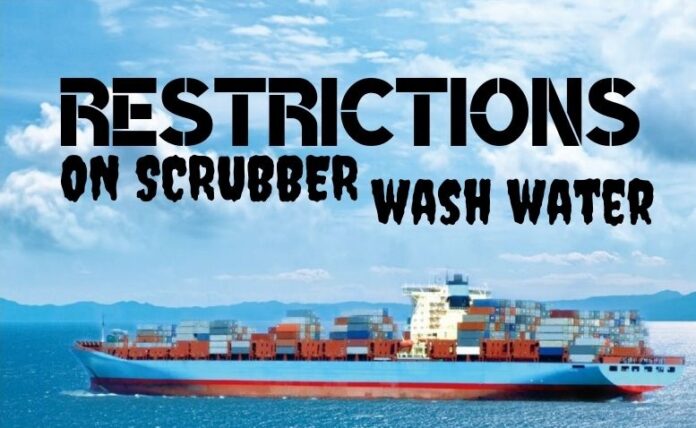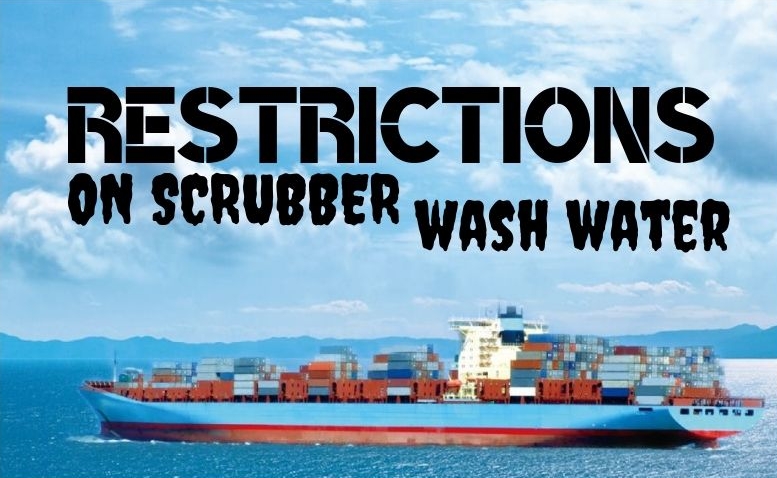
(www.MaritimeCyprus.com) The IMO considers exhaust gas scrubbers to be an acceptable means of reducing vessels’ sulphur emissions and ensuring compliance with MARPOL Annex VI. A separate guideline, Resolution MEPC.259(68), specifies the requirements for the verification, testing, survey and certification of scrubber systems and sets out the criteria for discharging scrubber washwater into the sea.
However, some coastal states and ports have implemented local regulations with more stringent requirements that restrict or completely prohibit the discharge of washwater from open loop scrubbers or prohibit the use of scrubbers. We are currently aware of the following regions/states/ports with local regulations that have an effect on the discharge of exhaust gas scrubber washwater, although the list should not be considered as complete.
Readers are aware that in addition to using compliant fuel to meet the 0.50% sulphur requirement that entered into force on 1 January 2020, there also exists the option to use “equivalent” compliance mechanisms in accordance with Regulation 4 of MARPOL Annex VI, one of which is the use of Exhaust Gas Cleaning Systems (EGCS) commonly known as Scrubbers.
In this regard the ICS Secretariat had circulated MC(19)04 that contained an initial list, which has been most recently revised in MC(20)54 that contained updates to the list of ports around the world that were identified as prohibiting the discharge from open loop scrubbers by ships visiting these ports.
Based on further related information received from the Clean Shipping Alliance, the ICS Secretariat has updated the list as provided below.
Country | Port/Sea area | Additional information |
Albania | All ports | |
Australia | Port of Hastings | |
Belgium | All ports and inland sea areas | |
Belize | ||
Bermuda | ||
Brazil | Terminal of Ponta da Madeira | All ports owned by Vale |
Complex of Tubarao e Praia Mole Ports | ||
Terminal of Ilha Guaibe | ||
Canada | Port of St John | |
Port Cartier | ||
China | Inland River ECA's | |
Waters of ports in Coastal ECA's | ||
Bohai Sea waters | ||
Columbia | Internal waters, territorial sea area, and the contiguous Colombian zone | |
Croatia | Port areas | |
Egypt | Suez Canal | |
Finland | Port of Porvoo | |
France | Cannes | Restriction applies to cruise ships only |
Marseille | ||
Le Havre | ||
Cherbourg | ||
Reunion | ||
Dunkirk | ||
Georgia | ||
Germany | Port of Hamburg | |
Port of Rostock | ||
River Elbe | ||
Ghana | ||
Gibraltar | ||
Ireland | Port of Dublin | |
Port of Waterford | ||
Port of Cork | ||
Port of Bantry | ||
Shannon Foynes Port | ||
Kenya | Within port limits | |
Malaysia | Within 12 nautical miles of land | |
Mauritius | Within 12 nautical miles of land | |
Mozambique | Nacala Port | |
Norway | The World Heritage Fjords | |
Port of Eidfjord | ||
Port of Stavanger | ||
Oman | ||
Pakistan | Port of Karachi | |
Port of Bin Qasim | ||
Panama | Panama Canal | |
Portugal | Port of Aveiro | |
Port of Leixoes | ||
Port of Lisbon | ||
Port of Sines | ||
Qatar | ||
Romania | Within port limits | |
Singapore | Within port limits | |
Slovenia | ||
South Korea | Incheon (including Kyongin Port) | * Restrictions also apply to all ships at anchor in all ports |
Pyeongtaek-Dangjin | ||
Yeosu | ||
Gwang-yang (including Haodng port) | ||
Busan | ||
Ulsan | ||
Spain | Port of Cadiz | |
Port of Algeciras | ||
Port of Cartegena | ||
Port of Huelva | ||
Port of Barcelona (at berth) | ||
Canary islands ports | ||
Port of Gijon | ||
Sweden | Port of Stenungsund | |
Port of Trellebord | ||
Port of Gothenburg | ||
Port of Oxelosund | ||
Port of Petroport | ||
Turkey | ||
United Arab Emirates | Port of Fujarah | |
Port of Dubai | ||
United States of America | Ports of Conneticut | |
Port of Seattle | Restriction applies to passenger cruise ships at berth in port terminals only |
Recommendations
Various other coastal states and ports are discussing enforcing similar bans citing the adverse effects of scrubber washwater on the marine environment. It is therefore likely that the above list of states/ports which currently regulate open loop scrubber discharges in their waters will grow over time. In those areas where the discharge of washwater is not permitted, vessel operators have two options to choose from to ensure compliance with the sulphur limits:
- use compliant fuel instead of open loop scrubbers; or
- switch over to closed loop mode of operation, in which case it will be necessary to convert currently installed open loop systems to closed loop or hybrid systems, if not already done.
Any changeover should be carried out well in advance of the vessel entering the areas with prohibition or restrictions in place. This will help in identifying operational issues, if any, after the changeover, and will allow for sufficient time to rectify such before the vessel enters the area.
The above list is intended to aid ships fitted with open loop scrubbers to plan in advance accordingly. In any case, companies are recommended to obtain further clarifications from relevant authorities before their ships visit these ports. There is information of hefty fines being imposed on ships that do not follow individual port requirements on this issue.
Source: ICS

For more IMO 2020 sulphur cap related guidance click here.













